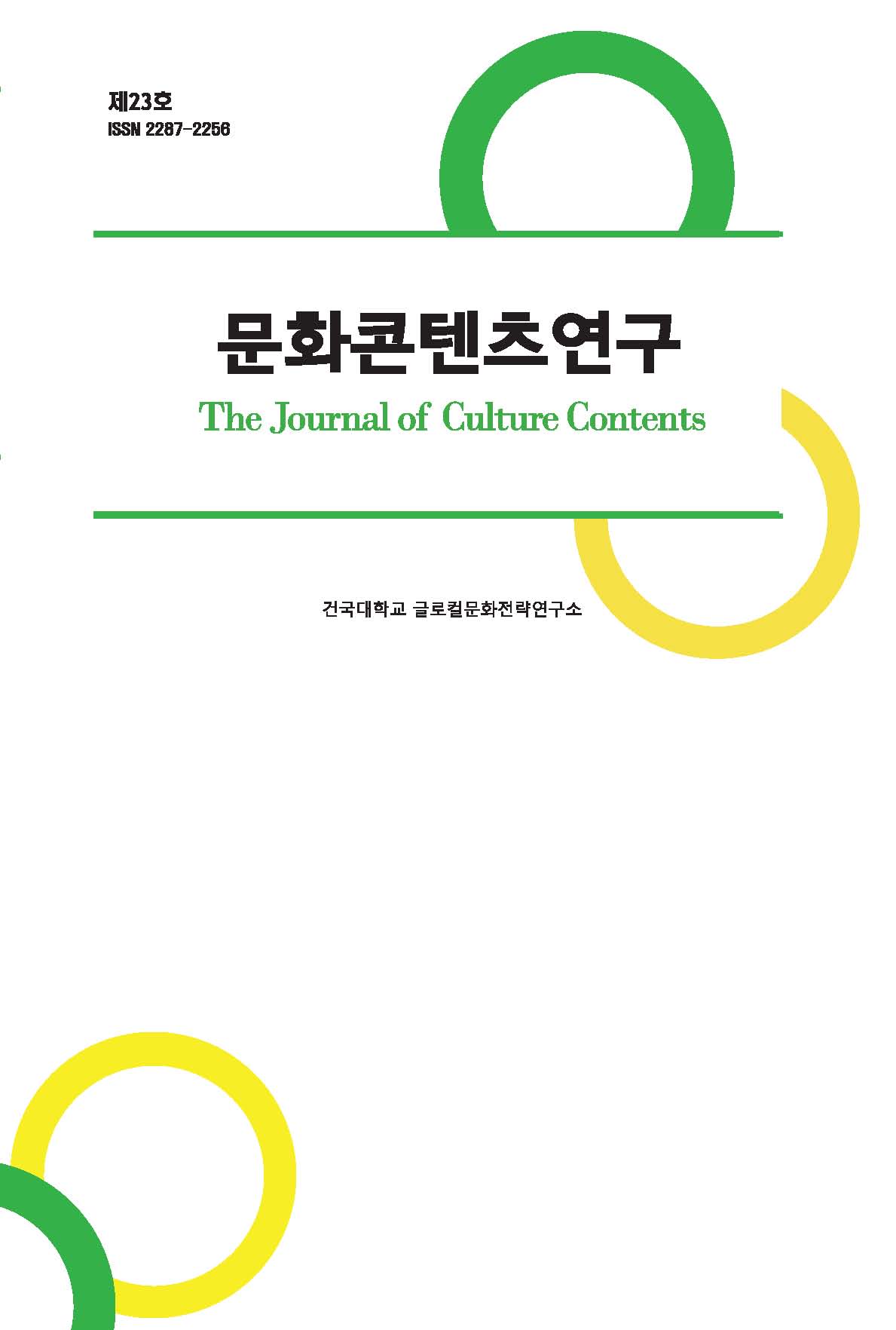Abstract
References
Information
This study introduces a new concept called “Female Universalism” and explores how this concept has been expressed and developed in Hallyu content. Female Universalism can be considered a concept that contrasts with the so-called “White Male Universalism,” portraying wise and empathetic representation of women in cultural content. In other words, while White Male Universalism contends that white male represent humanity as a rational and just group, Female Universalism proposes that women represent humanity though beauty, wisdom and empathy.
In so doing, the study applies the concept of melancholia, as presented by Freud and Butler, to explain the spread of Hallyu, arguing that female Hallyu fans alleviate this melancholia through the consumption of Hallyu. The paper argues that this is one of the significant factors in the global spread of Hallyu. The research illustrates various expressions of Female Universalism in the development of Hallyu and suggests that Female Universalism is now becoming a central aspect of Hallyu content.
Furthermore, the study is significant in offering a new direction for Korean studies. While most of the previous Korean studies mainly apply foreign theories and concepts to the Korean context, this study indicated the possibility of concepts developed in the Korean context influencing Western and international academia in return.
In so doing, the study applies the concept of melancholia, as presented by Freud and Butler, to explain the spread of Hallyu, arguing that female Hallyu fans alleviate this melancholia through the consumption of Hallyu. The paper argues that this is one of the significant factors in the global spread of Hallyu. The research illustrates various expressions of Female Universalism in the development of Hallyu and suggests that Female Universalism is now becoming a central aspect of Hallyu content.
Furthermore, the study is significant in offering a new direction for Korean studies. While most of the previous Korean studies mainly apply foreign theories and concepts to the Korean context, this study indicated the possibility of concepts developed in the Korean context influencing Western and international academia in return.
이 연구는 <여성보편주의>라는 새로운 개념을 제시하고, 한류 콘텐츠에서 이 개념이 어떻게 표현되고 전개되어 왔는지를 보여주는 것이다. 여성보편주의는 문화콘텐츠에서 표현되는 합리적면서 공감적인 여성의 모습으로, 서구의 백인남성보편주의에 대비되는 개념이라 할 수 있다. 즉, 서구 대중문화에서는 백인남성을 인류를 대표하는 합리적이고 정의로운 집단으로 표현하는 데 반하여, 한류 콘텐츠에서는 여성의 아름다움과 지혜, 용기와 공감을 강조한다는 것이다. 이 연구는 이 과정에서 프로이드와 버틀러 등에 의해 제시되었던 멜랑콜리아의 개념을 한류의 확산을 설명하는데 적용해서, 전 세계 여성팬들이 한류 소비를 통해 이러한 멜랑콜리아를 해소하고 극복하고 있고, 이것이 한류 확산의 주된 요인 중의 하나라는 점을 강조하였다. 이 연구는 한류의 확산과정에서 나타난 다양한 여성보편주의의 모습을 드라마와 케이팝을 중심으로 보여주었고, 이를 통해 여성보편주의가 한류콘텐츠의 중심이 되어 가는 사례들을 제시하였다. 이 연구는 한국학 연구에 새로운 방향을 제시한다는 점에서도 의의가 있다. 기존의 한국한 연구가 외국의 이론이나 개념들을 한국적 상황에 적용하는 것이 주를 이루었다면, 이 연구가 제시하는 여성보편주의는 한국적 상황에서 발전한 개념이 서구 및 국제 학계에 역으로 영향을 미칠 수 있는 가능성을 보여주고 있다.
- 교보증권리서치센터, 『6각형 스텟의 4세대 아이돌이 온다』, 교보증권리서치보고서, 2022.
- 김미라, 「TV드라마 <마인>의 여성주의 서사 –가부장제 클리셰의 파기와 질서의 전복-」, 『한국콘텐츠학회 논문지』, 제21권(11호), 한국콘텐츠학회, 2021.
- 김수정·양은경, 「동아시아 대중문화물의 수용과 혼종성의 이해」, 『한국언론학보』, 제50권(1호), 한국언론학회, 2006.
- 오현석, 「혼종성 이론에서 바라본 일본의 한류」, 『일본학』, 제45권, 동국대학교 일본연구소, 2017.
- 이수안, 「유럽의 ‘한류’를 통해 본 문화혼종화 – 케이팝 열풍을 중심으로」, 『한독사회과학논총』, 제22권(1호), 한독사회과학회, 2012.
- 이희진, 「중국인의 한국드라마 시청이 문화유입 수용성에 미치는 영향-한류호감 및 문화근접성의 매개효과 검증을 중심으로」, 『중국학연구』, 제82권, 중국학연구회, 2017.
- 정윤경·이기태, 「이질 문화권 수용자의 한국 영상물 이용과 문화적 근접성에 관한 연구」, 『미디어 경제와 문화』, 제9권(4호), ㈜에스비에스, 2011.
- 장원호·김익기·송정은, 『한류와 아시아 팝문화의 변동』, 푸른길, 2014.
- Butler, Judith, Gender Trouble, Routledge, 1990.
- ______, Bodies that Matter: On the Discursive Limits of Sex, Routledge, 1993.
- ______, “Melancholy gender—refused identification”,
Psychoanalytic Dialogues 5(2), Taylor & Francis, 1995. 10.1080/10481889509539059 - Butler, Judith, Ernesto Laclau and Slavoj Žižek, Contingency, Hegemony, Universality: Contemporary Dialogues on the Left, Verso, 2000.
- Chua, Beng H. and Kōichi Iwabuch (Eds), East Asian Pop Culture: Analyzing the Korean Wave, Hong Kong University Press, 2008.
- Cuningham, Henry, “Sherlock Holmes and the case of race”,
Journal of Popular Culture 28(2), Blackwell Publishing, 1994. 10.1111/j.0022-3840.1994.2802_113.x - Eng, David, L., “Melancholia in the late twentieth century”, Signs: Journal of Women in Culture and Society 25(4), The University of Chicago Press, 2000. 10.1086/495560
- Eng, David L. and Shinhee Han, Racial Melancholia, Racial Dissociation: On the Social and Psychic Lives of Asian Americans, Duke University Press, 2019. 10.2307/j.ctv11smqsk
- Epstein, Stephen and Rachael M. Joo, “Multiple exposures: Korean bodies and the transnational imagination”, The Asia-Pacific Journal 10(33.1), Harvard University Press, 2012.
- Epstein, Stephen, “Into the New World: Girls' Generation from the Local to the Global” in Choi, Jungbong and Roald Maliangkay, K-Pop - The International Rise of the Korean Music Industry, Routledge, 2015.
- Epstein, Stephen and James Turnbull, “Girls’ generation? Gender (dis)empowerment and K-Pop” In Kyung Hyun Kim and Youngmin Choe (Eds.), The Korean Popular Culture Reader, Duke University Press, 2014. 10.2307/j.ctv11smhw7.23 24697570
- Gilroy, Paul, After Empire, Routledge, 2004. 10.4324/9780203482810
- ______, Postcolonial Melancholia, Columbia University Press, 2004.
- Iwabuchi, Koichi, “Japanese popular culture and postcolonial desire for ‘Asia’ ” In Allen, Matthew and Rumi Sakamoto(Eds.), Popular Culture, Globalization and Japan, Routledge, 2006.
- ______, “Korean Wave and inter-Asian referencing” In Kim, Y. (Ed.), The Korean Wave: Korean Media Go Global, Routledge, 2013.
- Jang, Wonho, Ik Ki Kim, Kum Ju Jo and Jung Eun Song, “Multi-dimensional dynamics of Hallyu in the East-Asian region”, Korean Journal of Sociology 46(3),
Korean Sociological Association , 2012. - Jang, Wonho and Byung Min Lee, “The Glocalizing Dynamics of the Korean Wave”, Korean Regional Sociology 17(2),
Korean Regional Sociology Association , 2016. - Jang, Wonho and Youngsun Kim, “Envisaging the Sociocultural Dynamics of K-Pop: Time/Space Hybridity, Red Queen’s Race and Cosmopolitan Striving”,
Korea Journal 53(4), The Academy of Korean Studies, 2013. 10.25024/kj.2013.53.4.83 - Jenkins, Henty, Textual Poachers: Television Fans and Participatory Culture, Routledge, 1992.
- ______, “Fandom studies as I see it”,
Journal of Fandom Studies 2(2), Intellect, 2014. 10.1386/jfs.2.2.89_1 - Jung, Eun-Young, “Playing the Race and Sexuality Cards in the Transnational Pop Game: Korean Music Videos for the US Market”,
Journal of Popular Music Studies 22(2), University of California Press, 2010. 10.1111/j.1533-1598.2010.01237.x - Jung, Eun-Young, “K-Pop female idols in the West: Racial imaginations and erotic fantasies” In Youna Kim, (Ed.), The Korean Wave: Korean Media Go Global, Routledge, 2013.
- Kim, Gooyong, “Between hybridity and hegemony in K-Pop’s global popularity: A case of Girls’ Generation’s American Debut”, International Journal of Communication 11, USC Annenberg Press, 2017.
- Kim, Gooyong, “K-Pop Female Idols as Cultural Genre of Patriarchal Neoliberalism: A Gendered Nature of Developmentalism and the Structure of Feeling/Experience in Contemporary Korea”, Telos 184, Telos Press, 2018. 10.3817/0918184185
- Lister, Ruth, “A differentiated universalism”, In Campling, J. (Ed.), Citizenship: Feminist Perspectives, Palgrave, 2003. 10.1007/978-0-230-80253-7
- Lopes, Paul, Art Rebels: Race, Class and Gender in the Art of Miles Davis and Martin Scorsese, Princeton University Press, 2019. 10.1515/9780691189819
- Luo Hong and Laurina Zhang, “Scandal, Social Movement and Change: Evidence from #me too in Hollywood”, Management Science 68(2), Institute for Operations Research, 2020. 10.1287/mnsc.2021.3982
- Lyan, Irina and Alon Levkowitz, “From holy land to ‘Hallyu Land’: The symbolic journey following the Korean wave in Israel”,
Journal of Fandom Studies 3(1), Intellect, 2015. 10.1386/jfs.3.1.7_1 - Marinescu, Valentina, The Global Impact of South Korean Popular Culture: Hallyu unbound, Lanham, Lexington Books, 2014.
- Nelson, Dana D., National Manhood: Capitalist Citizenship and the Imagined Fraternity of White Men, Duke University Press, 1998. 10.1215/9780822382140
- Oh, Chuyun, “Queering spectatorship in K-Pop: The androgynous male dancing body and western female fandom”,
Journal of Fandom Studies 3(1), Intellect, 2015. 10.1386/jfs.3.1.59_1 - Oh, Ingyu, “Torn between two lovers: Retrospective learning and melancholia among Japanese Women”,
Korea Observer 42(2), Institute of Korean Studies, 2011. - Oh, Ingyu and Wonho, Jang, “From globalization to glocalization: Configuring Korean pop culture to meet glocal demands”, Culture and Empathy 3(1-2), The World Association for Hallyu Studies, 2020. 10.32860/26356619/2020/3.12.0003
- Oh, Ingyu, Hyun-chin Lim and Wonho Jang, “What is Female Universalism in Hallyu? - A Theoretical and Empirical Exploration”, Paper presented at 118th ASA Annual Meeting, Philadelphia, 17-21 Aufust 2023.
- Shim, Doobo, “Hybridity and the rise of Korean popular culture in Asia”, Media, Culture & Society 28(1), SAGE, 2006. 10.1177/0163443706059278
- Yang, Jonghoe, “The Korean wave (Hallyu) in East Asia: A comparison of Chinese, Japanese and Taiwanese audiences who watch Korean TV dramas”,
Development and Society 41(1), Institute for Social Development and Policy Research, 2012. 10.21588/dns.2012.41.1.005 - Yoon, Hesu and Hans Schattle, “The Gangnam style phenomenon as a global manifestation of hybridity”,
Asian International Studies Review 18(2), Institute for International and Area Studies, 2017. 10.1163/2667078X-01802001
- Publisher :Research Institute of Creative Contents
- Publisher(Ko) :글로컬문화전략연구소
- Journal Title :The Journal of Culture Contents
- Journal Title(Ko) :문화콘텐츠연구
- Volume : 29
- Pages :331-357
- DOI :https://doi.org/10.34227/tjocc.2023..29.331



 The Journal of Culture Contents
The Journal of Culture Contents





